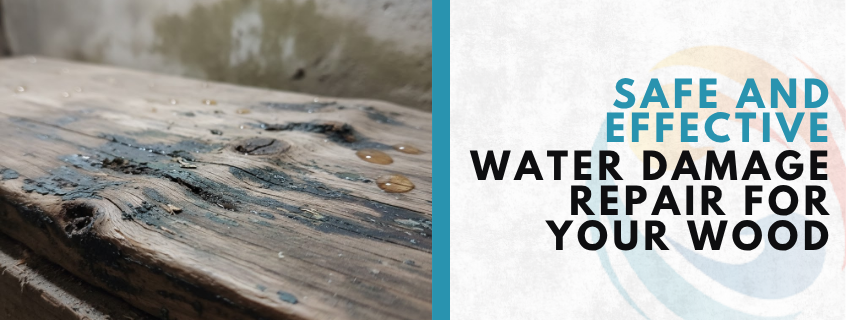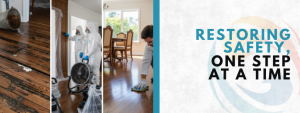In humid coastal areas like El Segundo, wood surfaces face constant exposure to moisture and humidity. Over time, leaks, spills, or condensation can leave behind stains, swelling, or even rot. Learning how to repair water damaged wood is an essential skill for any homeowner who wants to maintain the beauty and longevity of their furniture, floors, or trim. With the right tools and techniques, you can bring life back to your wood and prevent future damage.
Understanding the Effects of Water on Wood
When water seeps into wood, it disrupts its natural fibers, causing swelling, discoloration, and deterioration. If ignored, the damage worsens—especially in coastal cities like El Segundo, where the air naturally carries higher moisture levels.
Common Signs of Water Damage
- Discoloration or dark spots that spread across the surface
- Swelling and warping that cause uneven boards or cracked joints
- Soft, spongy textures indicating wood decay
- Mold or musty odors caused by trapped moisture
Recognizing these signs early is the first step in effective wood water damage repair and long-term prevention.
Step-by-Step Guide: How to Repair Water Damaged Wood
Knowing how to repair water damaged wood properly ensures your surfaces look great and remain structurally sound for years. Follow these expert steps to restore your wood safely and effectively.
Step 1: Dry and Inspect the Area
Begin by drying the affected area completely. Use fans, open windows, and a dehumidifier to remove moisture. In El Segundo, where humidity can linger, allow at least 24–48 hours for proper drying.
Step 2: Clean and Sanitize
Wipe the surface using a mix of vinegar and water or a wood-safe cleaner. For mold or mildew, use a mild antimicrobial solution. Cleaning removes contaminants and prevents further decay.
Step 3: Sand and Smooth the Surface
Use fine-grit sandpaper to remove stains, raised grains, and rough textures. Sand along the wood grain to avoid scratches. This process also helps when repairing water stains on wood, allowing for a smooth base before refinishing.
Step 4: Fill Cracks and Restore Structure
If there are deep cracks or soft patches, apply a wood filler or epoxy compound. Once dry, sand again for a seamless finish. This strengthens weakened areas and prepares them for refinishing.
Step 5: Refinish and Seal
Apply a stain that matches the rest of your wood, then seal the surface with a protective polyurethane or waterproof coating. This step is crucial for homes in El Segundo, where coastal air can easily reintroduce moisture.
Preventing Future Wood Water Damage
Prevention is key when it comes to protecting wood in damp environments. Simple maintenance can save you from expensive restoration later.
Proactive Maintenance Tips
- Seal your wood regularly: Use a waterproof varnish or oil-based sealer every 1–2 years.
- Control indoor humidity: Keep indoor humidity between 30–50%.
- Fix leaks immediately: Address roof, plumbing, or HVAC leaks before they spread.
- Use mats or rugs: Place mats near doors and sinks to catch spills before they reach wooden floors.
- Maintain good airflow: Especially important in coastal homes like El Segundo.
Quick Prevention Checklist
| Task | Frequency | Benefit |
| Apply sealant | Every 1–2 years | Adds waterproof protection |
| Inspect for leaks | Every 6 months | Prevents structural damage |
| Deep clean wood | Every 3 months | Preserves color and finish |
| Use a dehumidifier | As needed | Reduces moisture buildup |
When to Hire Professionals
Sometimes, DIY methods aren’t enough—especially when the damage involves rot, mold, or large areas. A certified restoration company offers expert wood water damage repair services that go beyond surface fixes.
Professional Restoration Benefits
- Advanced tools for deep drying and moisture detection
- Mold and odor removal treatments
- Structural repair and refinishing services
- Insurance assistance for water-related damage
In El Segundo, professional restorers also understand how local climate conditions impact wood, helping you achieve lasting, high-quality results.
Key Takeaway: Lasting Solutions for Water-Damaged Wood
Learning how to repair water damaged wood not only saves money but also helps preserve the warmth and character of your home—especially in humid coastal areas like El Segundo. With proper drying, sanding, sealing, and refinishing, you can restore your wood’s natural strength and appearance, preventing long-term structural issues.
However, when the damage is extensive or mold has begun to spread, it’s best to call experts in Water Damage Restoration El Segundo. Professional technicians have the tools, experience, and precision needed to restore your property safely and efficiently. Acting quickly ensures your home remains sturdy, beautiful, and fully protected against future moisture damage.
FAQ: Water Damage and Stain Repair
Q: How can I remove white or cloudy stains on wood?
A: For removing water stains from wood, use a mix of baking soda and water or gently rub petroleum jelly over the mark overnight before wiping clean.
Q: Can I repair wood that’s started to rot?
A: Minor rot can sometimes be filled with epoxy, but extensive decay requires professional replacement.
Q: How long should I wait before refinishing after water exposure?
A: Wait until the wood feels completely dry—usually 24 to 72 hours, depending on humidity.
Q: What’s the best finish to protect wood from moisture?
A: Use polyurethane, lacquer, or marine-grade varnish for strong water resistance.
Q: Is it safe to repair water damage myself?
A: Small surface damage is fine for DIY repair, but deep structural or moldy wood should be handled by restoration professionals.







